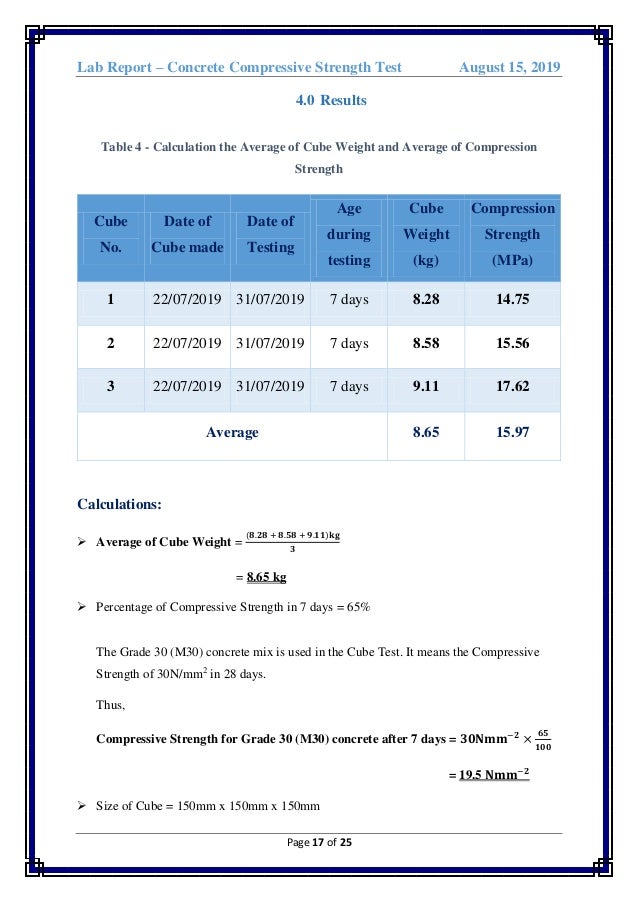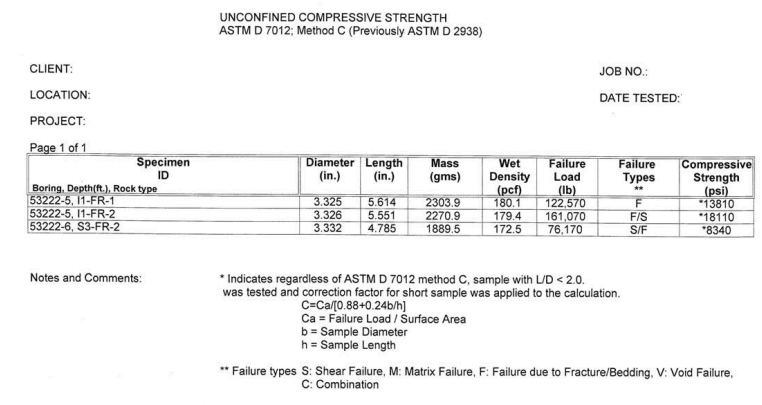Compressive Strength Test Lab Report
The shear strength of the soil material is defined as the point with the higher recorded horizontal stress. Steel Coupler Slip Test.
For every test the horizontal shear stress is plotted versus the shear displacement.

. Mechanical sieve shaker Optional Materials Coarse aggregate Fine aggregate Procedure 3. Advance Testing Research. Similarly again drive sampler in soil and count the blows needed to.
Depending on the soil density a different behavior in terms. The temperature of the test. The compressive strength of concrete test is one of the post-test widely doing at the site to find out the compression strength of particular concrete batch.
Your report should include the following. Objective of the test. Get Involved MEMBERSHIP MEETINGS.
Light brown sandy Silt The volume of the Bottle. Basic Concrete Type Q certification. We will look at a very easy experiment that provides lots of information about the strength or the mechanical behavior of a material called the tensile test.
Nova-Institute Renewable Carbon Strategies. This guide will teach you how to perform compressive strength testing. Shear Stress Shear stress corresponding to 13 of the compressive strength - Shear stress corresponding to 120 of the compressive strength.
The average compressive normal strain near the GB was 05 and the corresponding compressive stress was 850 MPa with an elastic modulus of 170 GPa. Use the template provided to prepare your lab report for this experiment. There are three categories of Concrete laboratory certification.
Nova-Institute is a private and independent research institute founded in 1994. 51 Care must be exercised in the interpretation of the significance of compressive strength determinations by this test method since strength is not a fundamental or intrinsic property of concrete made from given materials. The age of each block shall be 28 days.
Nova offers research and consultancy with a focus on the transition of the chemical and material industry to renewable carbon. Roman concrete also called opus caementicium is a material that was used in construction in Ancient RomeRoman concrete was based on a hydraulic-setting cementIt is durable due to its incorporation of pozzolanic ash which prevents cracks from spreadingBy the middle of the 1st century the material was used frequently often brick-faced although variations in aggregate. However remolded sand samples can also be tested.
Axial stress vs axial strain graph Report. The compressive strength testing machine consist of two steel bearing blocks one is in rigid position on which the masonry unit is placed and another one is movable which transmit the load to the masonry unit when applied. Test procedures optional Analysis of test results Complete the table provided and show one sample calculation.
Global Lab offers Rebound hammer test to assess likely compressive strength of Concrete. 1 the constant head test method and 2 the falling head test method. Take an average of 3 values these values should not vary by more than 2 to 3.
But the test is inappropriate for dry sands or crumbly clays because these materials would fall apart. DIME is a web application developed by the California Department of Transportation Materials Engineering Testing Services METS to allow material testing laboratories the ability to easily submit sample information and test data to Caltrans database via the internet. Objective of the test.
Download Free PDF View PDF. Applications of the test. Cement.
Unconfined compressive strength q u 715 kPa Undrained cohesion c u q u 2 3575 kPa. The unconfined compression test method is used primarily for saturated cohesive soils recovered from thin-walled sampling tubes. The American Concrete Institute recognizes 28 days or the test age designated for determination of the specified compressive strength5 Therefore when a specifier calls for 5000 psi concrete at 28 days this tells the concrete producer to select a mix design that will attain a minimum of 5000 psi 28 days after manufacture.
It is intended to be a supplement to reading the. Your report should include the following. Two general types of permeability test methods are routinely performed in the laboratory.
Apparatus A set of IS Sieves Balance or scale with an accuracy to measure 01 percent of the weight of the test sample. Values obtained will depend o. Type A soils with an unconfined compressive strength of 15 tsf can be readily indented by the thumb.
Draw the grain size distribution curve. The test is generally performed on cohesive soil specimens. Torsion Test on Mild Steel and Cast Iron - Lab Report.
The constant head test method is used for cohesionless and more permeable soils k10-4 cms and the falling head test is mainly used for cohesive or less permeable soils k. It covers the reasons you are performing this test the equipment needed and the procedure of ASTM C39. The test sample is dried to a constant weight at a temperature of 110 5C and weighed.
The unconfined compression strength test is the most popular laboratory test used to determine the compressive strength of soil. However they can be penetrated by the thumb only with very great effort. For more accurate results it is recommended to conduct tests 3 times on the same soil sample.
The blocks should be tested with in 3days after collected in lab. Now Count the number of blows required to reach or drive depth of 150 mm 6 in. Firstly drive the drop hammer on the bottom of a borehole by blows from the slide hammer with a mass of 635 kg falling through a distance of 750 mm 30 in at the rate of 30 blows per minute.
Welcome To DIME Data Interchange for Materials Engineering. Basics and Principles of Plastic Analysis. Now to move the digital report We implemented QR code system on reports to know about the authenticity of.
A sample calculation for Specific Gravity of Soil is shown in the table given below. Use the template provided to prepare your lab report for this experiment. The consolidated drained CD test describes the long-term loading response and provides the strength parameters determined under effective stress control ie.
Applications of the test. Load KN Tensile Strength KgSqcm Average Strength. The high shear stresses applied enabled GB sliding at room temperature 35 and the high compressive stresses drove the transfer of two 331 layers.
The basic idea of a tensile test is to place a sample of a material between two fixtures called grips which clamp the material. Type C soils with an unconfined compressive strength of 05 tsf can be easily penetrated several inches by the thumb and can be molded by light finger pressure. The American Concrete Institute ACI is a leading authority and resource worldwide for the development and distribution of consensus-based standards technical resources educational programs certification programs and proven expertise for individuals and organizations involved in concrete design construction and materials who share a commitment to pursuing the best.
In addition all new Concrete laboratories applying for certification must participate in an inter-lab correlation test to demonstrate their proficiency and ability to produce reliable test results on compression samples. Road Construction Materials Basic Knowledge and Test Procedures. Global Lab does the slip test on the steel coupler as per IS 16172.
ANALYSIS AND EXECUTION OF ROAD WORK ON NH-5 MAIN PROJECT REPORT.

Compression Lab Report The American University In Cairo Engr 2112 Strength And Testing Of Studocu

Unconfined Compressive Strength Test Of Soil Laboratory Test Geotech With Naqeeb Youtube

Unconfined Compressive Strength Test Of Rock

The Test Results Compressive Strengths Of Concrete And Red Mud Cubes Download Table
No comments for "Compressive Strength Test Lab Report"
Post a Comment